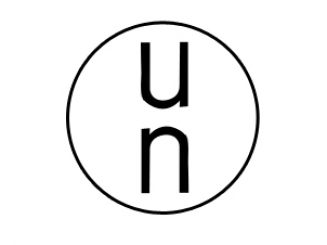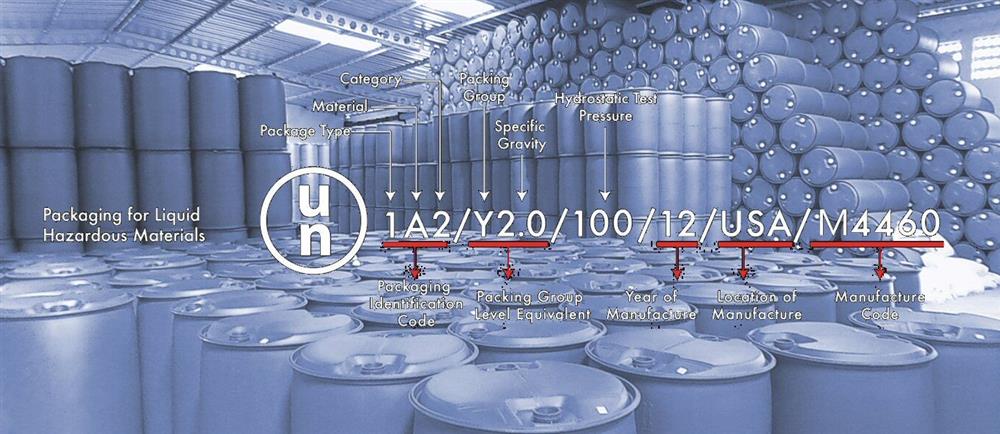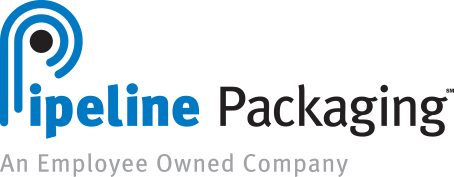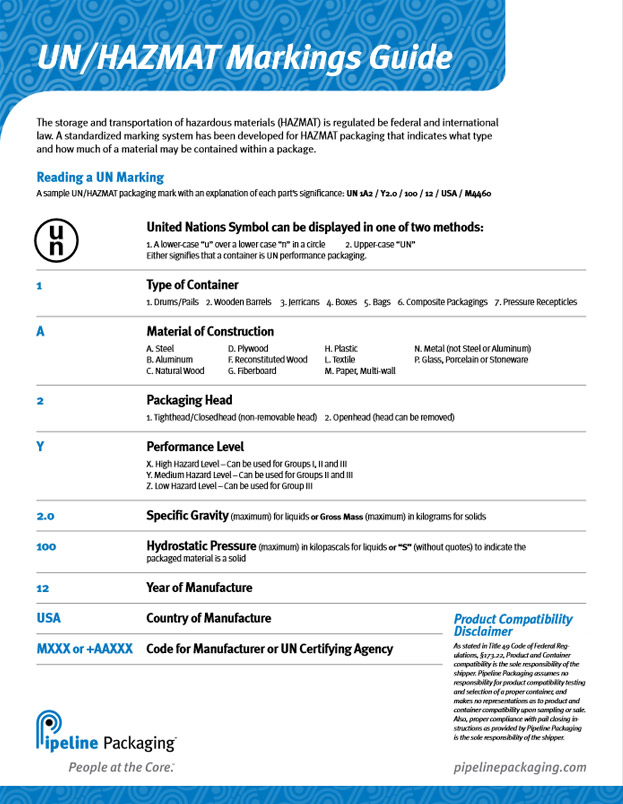UN Markings for
Hazardous Materials
The storage and transportation of hazardous materials (HAZMAT) is regulated by federal and international law. A standardized marking system known as the UN marking guide, has been developed for HAZMAT packaging that indicates what type and how much of a material may be contained within a package.
Reading UN Markings

UN/HAZMAT markings are a series of six codes that are separated by slashes. Each group of codes provides relevant identifying information about that specific package. A UN marking is required to appear on any package that has been UN certified and is to be used for the transportation of hazardous materials.
Example: UN 1A2 / Y2.0 / 100 / 12 / USA / M4460
This is a UN-certified, openhead, steel pail. It can safely contain mid-to-low level hazardous liquids with a specific gravity no greater than of 2.0 and endure pressure up to 100 kilopascals during transportation and storage. Finally, the US-made pail was built in 2012 by Cleveland Steel Container.
What is Considered a Hazardous Material?
The U.S Department of Transportation defines a hazardous material as, “any substance that can pose an unreasonable risk to health, safety, and property when transported in commerce. Substances include, but are not limited to, aerosols, fuels, lithium batteries, paints, dry ice, mercury, and refrigerant gases. Since shippers have the responsibility to ensure that hazardous materials are being properly stored and transported, UN rated containers are often the best packaging option available. Learn more by exploring our packaging options and product specifications.
Understanding a UN Marking
Below is a breakdown of the above UN marking example, above. Each element of the code is detailed with the possible options that can be used to identify the different types of UN rated containers. This system was embraced by the US Department of Transportation (DOT) to ensure that hazardous materials are being safely transported.

"UN" = United Nations Symbol, which can be displayed in one of two methods:
- A lower-case “u” over a lower case “n” in a circle
- Upper-case “UN”
Either signifies that a container is UN performance packaging.
UN 1A2 / Y2.0 / 100 / 12 / USA / M4460
"1" = Type of Container
1 = Drums/Pails 3 = Jerricans 5 = Bags 7 = Pressure Receptacles
2 = Wooden Barrels 4 = Boxes 6 = Composite Packagings
UN 1A2 / Y2.0 / 100 / 12 / USA / M4460
“A” = Material of Construction
A. Steel
B. Aluminum
C. Natural Wood
D. Plywood
F. Reconstituted Wood
G. Fiberboard
H. Plastic
L. Textile
M. Paper, Multi-wall
N. Metal (not Steel or Aluminum)
P. Glass, Porcelain or Stoneware
UN 1A2 / Y2.0 / 100 / 12 / USA / M4460
"2" = Packaging Head
1 =Tighthead/Closedhead (non-removable head) 2 = Openhead (head can be removed)
UN 1A2 / Y2.0 / 100 / 12 / USA / M4460
"Y" = Performance Level
X = High Hazard Level – Can be used for Groups I, II and III
Y = Medium Hazard Level – Can be used for Groups II and III
Z = Low Hazard Level – Can be used for Group III
UN 1A2 / Y2.0 / 100 / 12 / USA / M4460
"2.0" = Specific Gravity (maximum) for liquids or Gross Mass (maximum) in kilograms for solids
UN 1A2 / Y2.0 / 100 / 12 / USA / M4460
"100" = Hydrostatic Pressure (maximum) in kilopascals for liquids or “S” (without quotes) to indicate the packaged material is a solid
UN 1A2 / Y2.0 / 100 / 12 / USA / M4460
"12" = Year of Manufacture
UN 1A2 / Y2.0 / 100 / 12 / USA / M4460
"USA" = Country of Manufacture
UN 1A2 / Y2.0 / 100 / 12 / USA / M4460
"M4460" = Unique Code for:
Mxxxx = Packaging Manufacturer +AAxxxx = UN Certifying Agency
Related Resources
UN/HAZMAT Markings Guide
Download our UN Marking Guide, detailing everything from container type and performance level to the year and country of manufacture.



